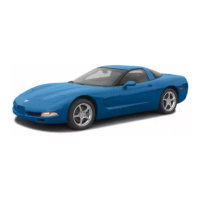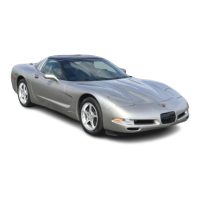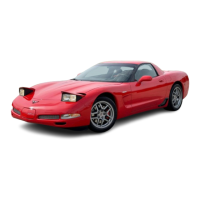Do you have a question about the Chevrolet Corvette 2021 and is the answer not in the manual?
How to locate information using the index.
Explains hazard symbols and their meanings for safety.
Explains symbols used in the manual for operation and information.
Lists and explains additional symbols found on the vehicle.
Covers keys, remote keyless entry, and door locks.
Information on hood and hatch/trunk operation.
Details on alarm systems and immobilizer.
Information on convex, power, and folding mirrors.
How to adjust the rearview mirror.
General warning about leaving children in a vehicle.
Warning about closing windows on children and operation.
Procedures for removing or installing a removable roof panel.
Guidelines for operating the convertible top to prevent damage.
How to open and close the tonneau cover for engine access.
Information on non-adjustable and non-removable head restraints.
Warning about power seats operating when ignition is off.
Warning about adjusting the driver seat while moving.
How to adjust lumbar support.
Warning about sitting in a reclined position while driving.
Details on memory seat features and linking to keys.
Warning about seat heater use and potential burns.
Warning about improper seat belt use in a crash.
Explains how seat belts function and their importance.
Explains how to wear a lap-shoulder belt properly.
Information on seat belt pretensioners.
Information on vehicle airbags and system checks.
Information on the passenger airbag status indicator.
Guidance for older children and infants.
Instructions for securing child restraints using LATCH and seat belts.
Warning about storing heavy or sharp objects in compartments.
Operation and locking of the glove box.
Accessing the cupholders.
Information on front storage and convenience nets.
Caution about sharp objects in rear storage and convenience nets.
Description of center storage and wireless charger.
Operation of the center console and its contents.
Cargo tie-downs and convenience nets for securing loads.
List of controls including steering wheel, horn, and wipers.
Explanation of warning lights and gauges.
Overview of the instrument cluster display.
How to navigate the cluster menu and its options.
Performance menu options including G-force and timers.
Indicates fuel level in the tank.
Shows engine coolant temperature.
Displays abnormal transmission temperatures.
Information on driver and front passenger seat belt reminders.
Indicates electrical problems with the airbag system.
How the passenger airbag status indicator works.
Operation of the charging system light.
Explanation of the check engine light and its cautions.
Indicates when the front of the vehicle is raised or lowered.
Warning about brake system operation and potential crashes.
Operation of the electric parking brake light.
Warning for service needed on electric parking brake.
Operation and issues with ABS warning light.
Display of light when Sport Mode is activated.
Explanation of the traction off light.
Explanation of ESC off light.
Information about tire pressure and TPMS.
Caution about engine oil maintenance.
Operation of the security light.
When the high-beam indicator light comes on.
When the exterior lamps are in use.
Operation of the cruise control light.
When a door is open or not securely latched.
Explanation of the DIC display.
Information displayed on the windshield.
Read pages to become familiar with features.
How the infotainment system is controlled.
How to display the active audio source page.
How to display the phone main page.
How to display the embedded navigation map.
How to sign in or create a user profile.
How to display the Settings menu.
How to activate Apple CarPlay.
How to activate Android Auto.
How to download and use in-vehicle apps.
How to access OnStar services.
How to access the camera application.
Description of the shortcut tray.
How display features appear and highlight.
Finger gestures to control the infotainment system.
Used to select icons, activate applications, or change map location.
Used to start gestures or move/delete applications.
Used to move applications or pan maps.
Used to move items on lists or maps.
Used to scroll lists, pan maps, or change page views.
Used to zoom in on maps or images.
Used to zoom out on maps or images.
Detailed cleaning instructions for displays and surfaces.
How to download and install software updates.
Playing the radio and selecting audio sources.
Adjusting equalizer, fade/balance, and sound mode.
Accessing radio categories to find stations.
Saving and recalling favorite stations.
Features of HD Radio service.
How to access HD Radio stations.
How to tune to specific stations using the keypad.
Troubleshooting common HD Radio issues.
How RDS features work with FM stations.
SiriusXM Radio service and subscription information.
Enhanced SiriusXM experience.
Factors affecting radio reception.
Caution about mobile device usage causing radio interference.
How the AM-FM antenna system works.
Caution about using untrusted media devices.
Information about USB ports for data and charging.
Requirements for USB devices.
How Gracenote service builds voice tags for music.
Accessing content from indexed media sources.
How to browse USB content by playlists, artists, songs, folders.
Use of the auxiliary input jack.
Playing music from a paired Bluetooth device.
How to add or delete Bluetooth devices.
Pairing smartphones using NFC.
Steps to pair a phone to the vehicle.
Connecting to the primary paired phone.
Enabling a phone as secondary for incoming calls.
How to view paired phones.
Steps to disconnect a phone.
Steps to forget a paired phone.
How to link to a different phone.
How to switch between handset and handsfree modes.
Making calls using contacts and recent calls.
Making calls by dialing numbers.
Searching contacts using the keypad.
How to accept or decline an incoming call.
Capability of Android Auto and Apple CarPlay.
Steps for wired phone projection.
Potential disruptions to wireless projection.
Steps to disconnect wireless projection.
Information on Android Auto and Apple CarPlay providers.
Managing settings in Owner Center.
Menu contents for System settings.
Features to set the clock.
Setting display language and voice recognition language.
Connecting, disconnecting, and deleting phones.
Showing connected and available Wi-Fi networks.
Using vehicle hotspot services.
Location services and voice recognition sharing settings.
Adjusting navigation map appearance.
Maximum startup volume and audio cues settings.
Confirm More/Less, Prompt Length, Audio Feedback Speed, Friendly Prompts.
Managing audio, phone, and navigation favorites.
Auto Fan Speed, Air Quality Sensor, Auto Cooled Seats, Auto Heated Seats.
Set Up My Places, Map Preferences, Route Preferences, Navigation Voice Control, Traffic Preferences, Alert Preferences, Manage History, About.
My Number, Active Call View, Privacy, Sort Contacts, Re-sync Device Contacts, Delete All Vehicle Contacts, OnStar Phone TTY Mode.
Adjustment of different vehicle features.
Adjustment of user profile settings.
Encouraging safe driving habits with multiple keys.
Buckle To Drive and Audio Volume Limit settings.
Setting a maximum radio volume limit.
Limiting maximum vehicle speed.
Setting speed warnings.
Filtering explicit content on SiriusXM.
Radio muting and safety system behavior.
Driver consent for recording vehicle data.
Cumulative data saved for trips.
FCC Information and "Made for" certifications.
Music recognition technology and data provided by Gracenote.
Gracenote terms of use and data usage.
Disclaimer of warranty for the database.
Limitation of liability for Gracenote.
Software license grant and restrictions.
Overview of dual automatic climate control system.
Using air outlet tabs for airflow direction.
Information on the passenger compartment air filter.
Caution about driving without an air filter.
Information on refrigerant and AC system service.
Tips for driving for better fuel economy.
Warning about distractions and laws regarding them.
Principles of defensive driving.
Dangers of driving under the influence.
Importance of braking, steering, and accelerating.
Factors in braking action and helpful tips.
Caution about steering system damage.
How electric power steering works and its maintenance.
Explanation of Dynamic Rack Travel feature.
Tips for taking curves safely.
Steering techniques in emergencies.
Tips for recovering from dropping off the road edge.
Types of skids and how to avoid them.
Warning about using Z51 package for track events.
Caution about oil usage for track events.
Reducing AC use for engine performance.
Recommended fuel octane.
Changing transmission fluid and filter.
Importance of brake fluid and replacement.
Specific processes for bleeding and flushing the brake system.
Steps for brake burnishing procedure.
Adjusting spring seats for track use.
Caution about excessive tire wear from alignment settings.
Reducing traction on wet roads.
Explanation of hydroplaning.
Tips for driving on hills and mountains.
Driving on snow or ice.
Warning about spinning tires at high speed.
How to rock the vehicle to get it unstuck.
Importance of knowing vehicle weight capacity.
Information on the certification label.
Recommended guidelines for new vehicle break-in.
Information on front air dam and splitter clearance.
Warning about sharp edges of composite materials.
Electronic keyless ignition with pushbutton start.
How to turn off the engine.
Mode for electrical accessories when engine is off.
Power mode for service and diagnostics.
Caution about adding electrical parts and shifting to Park.
Warning about shifting into Park.
Warning about leaving vehicle with engine running.
How to shift out of Park.
Warning about parking over flammable materials.
How Active Fuel Management works.
Description of the dual clutch transmission.
How to use manual paddle shift controls.
How to temporarily disconnect the engine from wheels.
Electric brake boost operation.
How ABS helps prevent braking skids.
Using ABS for steering and braking.
How the Electric Parking Brake (EPB) works.
Steps to apply the EPB.
Steps to release the EPB.
Detects rapid brake pedal applications for emergency braking.
Warning about relying solely on HSA.
Traction Control (TCS) and StabiliTrak/ESC systems.
How to turn TCS/StabiliTrak/ESC off and on.
Allows driver to adjust driving experience by selecting modes.
How to activate My Mode, Weather, Tour, Sport, and Track.
Attributes for different driver modes.
Electronic Limited-Slip Differential system.
Mechanical limited-slip differential for improved traction.
Maintaining speed without using accelerator.
Steps to set cruise control.
Returning to a previously set cruise control speed.
How to increase speed while using cruise control.
How to decrease speed while using cruise control.
Using accelerator to increase speed while using cruise control.
How cruise control works on hills.
Cruise control operation in Manual Mode.
How to end cruise control.
Features that help avoid crashes or reduce damage.
How cruise control set speed is erased.
Rear Vision Camera, Rear Park Assist, Curb View Camera.
Displays image behind vehicle when in Reverse.
View of area in front of vehicle.
Rear cross traffic view.
Sensors detect objects behind vehicle while backing.
Lane-changing aid for side blind zones.
Sensor coverage zone for SBZA.
How the SBZA system alerts the driver.
Information on Top Tier fuel.
GM recommendation for engine cleanliness.
Specifies premium unleaded gasoline octane.
Caution about fuels that may damage the vehicle.
Information on fuel octane ratings in foreign countries.
Recommendation for fuel system treatment.
Warning about fuel vapors and fires.
Warning about filling portable fuel containers.
Warning against towing trailers.
Add-On Electrical Equipment warning.
Information on service and parts needs, and GM-trained technicians.
Warning about chemicals in vehicles and parts.
Information on perchlorate materials and special handling.
How accessories affect vehicle performance and warranty.
Warning about injury when lifting the vehicle.
Warning about performing service work without proper knowledge or tools.
Identification of components in the underhood compartment.
Overview of the 6.2L V8 Engine (Coupe/Convertible).
Importance of engine oil for performance and longevity.
Procedure for checking engine oil level in a dry sump system.
How to add engine oil and capacity information.
Procedure for changing engine oil and filter.
Choosing the correct engine oil specification and viscosity.
How the system indicates when to change engine oil.
Steps to reset the engine oil life system.
Information on dual clutch transmission fluid.
Checking transmission fluid level and replacement.
How the system indicates when to change transmission fluid.
Feature for engine air filter remaining life.
When to replace the engine air filter.
Steps to reset the engine air filter life system.
Caution about water entering the engine air cleaner/filter.
How the cooling system works.
Warning about using plain water or wrong coolant mixture.
Steps for adding coolant to the surge tank.
Indicators of engine overheating.
What to use for windshield washer fluid.
Information on disc brake linings and wear indicators.
Checking brake fluid level and reservoir.
Information on the original equipment battery.
Warning about battery acid and gas.
Warning about vehicle movement during checks.
Inspection and replacement of windshield wiper blades.
Information on replacing the windshield.
Benefits of an acoustic windshield.
Warning about gas strut failure.
Front headlamp aim adjustment information.
Information on LED lighting replacement.
Protection against electrical system overload.
Fuses protect power devices in the vehicle.
Causes and solutions for electrical overload affecting lamps.
How wipers operate when the motor overheats.
How wiring circuits are protected by fuses.
Location and access to the instrument panel fuse block.
Location and access to the rear compartment fuse block.
Information on high-quality tires and warranty.
Performance characteristics of all-season tires.
Design and use of winter tires.
Information on run-flat tires and their limitations.
Susceptibility of low-profile tires to damage.
Characteristics of high-performance summer tires.
Explanation of tire sidewall markings.
Definitions of tire-related terms.
Importance of correct tire air pressure.
Inflation pressure adjustment for high-speed driving.
How the TPMS checks tire pressure levels.
Recommendations for inspecting tires for wear or damage.
Importance and timing of tire rotation.
Factors affecting tire wear and treadwear indicators.
GM recommendations for purchasing new tires.
Effects of different tire/wheel sizes on vehicle performance.
NHTSA grading system for tires.
Tips for handling a tire blowout.
Warning against using tire chains due to clearance issues.
Information about the vehicle battery.
Safe steps for jump starting a vehicle.
Caution about incorrectly towing a disabled vehicle.
Caution about improper use of the tow eye.
Keeping the vehicle looking new.
Washing the vehicle and cleaning exterior components.
Lubricating and greasing locks.
How to wash the vehicle to preserve its finish.
Caution about power washing underhood components.
Caution about potential damage from automatic car washes.
Procedure for hand washing the vehicle.
Application of aftermarket clearcoat sealant/wax.
Cleaning and protecting bright metal moldings.
Care instructions for the convertible top.
How to wash and wax carbon fiber parts.
Cleaning exterior lamps, lenses, emblems, decals, and stripes.
How to clean wheels and wheel trim.
Inspection of brake lines, hoses, pads, and rotors.
Inspection of steering, suspension, and chassis components.
Lubricating lock cylinders, hinges, and weatherstrips.
Flushing corrosive materials from the underbody.
How to clean the vehicle interior and remove soils.
Cleaning interior surfaces with soft cloths and mild solutions.
Cleaning fabric, carpet, and suede surfaces.
Cleaning high gloss surfaces and displays with microfiber cloths.
Keeping seat belts clean and dry.
Warning about improperly installed floor mats.
Warning against using silicone or wax-based cleaners.
Describes required maintenance and its importance.
Schedule for owner checks and services.
Services for severe commercial use vehicles.
Importance of additional maintenance for vehicle longevity.
List of recommended fluids, lubricants, and parts.
Log for recording scheduled services.
Information on Vehicle Identification Number (VIN).
Explanation of engine code in VIN.
Information found on the certification label.
Approximate capacities in metric and English conversions.
Table of approximate fluid capacities and wheel nut torque.
Details on engine, VIN code, transmission, spark plug gap, and firing order.
Specifications for engine horsepower, torque, displacement, and compression ratio.
Diagram showing engine drive belt routing.
Steps to resolve concerns with dealership management.
Contact information for customer assistance.
How to order service manuals and customer literature.
Vehicle's compliance with FCC and ISED rules.
How to report safety defects to government agencies.
Information on vehicle computers and data collection.
GM's collection and protection of vehicle data.
Purpose and data recorded by event data recorders.
Information about OnStar services and system operation.
Storage of destinations, addresses, and trip information.
Explanation of OnStar system status lights and buttons.
Emergency, Security, Navigation, Connections, Diagnostics services.
In-Vehicle Audio Messages and Transferring Service.
Overview of Navigation, Connections, and Diagnostics.
Requires OnStar or connected service plan.
How to receive Turn-by-Turn directions.
Functionality of voice commands during navigation.
Steps to cancel a route.
How to preview upcoming maneuvers.
How to repeat the last direction given.
How to get destination address and distance.
Services for staying connected.
Changing Wi-Fi hotspot and mobile app passwords.
Using the built-in Wi-Fi hotspot.
Accessing vehicle services from a smartphone.
Monitoring and reporting vehicle systems for maintenance.
How to locate information using the index.
Explains hazard symbols and their meanings for safety.
Explains symbols used in the manual for operation and information.
Lists and explains additional symbols found on the vehicle.
Covers keys, remote keyless entry, and door locks.
Information on hood and hatch/trunk operation.
Details on alarm systems and immobilizer.
Information on convex, power, and folding mirrors.
How to adjust the rearview mirror.
General warning about leaving children in a vehicle.
Warning about closing windows on children and operation.
Procedures for removing or installing a removable roof panel.
Guidelines for operating the convertible top to prevent damage.
How to open and close the tonneau cover for engine access.
Information on non-adjustable and non-removable head restraints.
Warning about power seats operating when ignition is off.
Warning about adjusting the driver seat while moving.
How to adjust lumbar support.
Warning about sitting in a reclined position while driving.
Details on memory seat features and linking to keys.
Warning about seat heater use and potential burns.
Warning about improper seat belt use in a crash.
Explains how seat belts function and their importance.
Explains how to wear a lap-shoulder belt properly.
Information on seat belt pretensioners.
Information on vehicle airbags and system checks.
Information on the passenger airbag status indicator.
Guidance for older children and infants.
Instructions for securing child restraints using LATCH and seat belts.
Warning about storing heavy or sharp objects in compartments.
Operation and locking of the glove box.
Accessing the cupholders.
Information on front storage and convenience nets.
Caution about sharp objects in rear storage and convenience nets.
Description of center storage and wireless charger.
Operation of the center console and its contents.
Cargo tie-downs and convenience nets for securing loads.
List of controls including steering wheel, horn, and wipers.
Explanation of warning lights and gauges.
Overview of the instrument cluster display.
How to navigate the cluster menu and its options.
Performance menu options including G-force and timers.
Indicates fuel level in the tank.
Shows engine coolant temperature.
Displays abnormal transmission temperatures.
Information on driver and front passenger seat belt reminders.
Indicates electrical problems with the airbag system.
How the passenger airbag status indicator works.
Operation of the charging system light.
Explanation of the check engine light and its cautions.
Indicates when the front of the vehicle is raised or lowered.
Warning about brake system operation and potential crashes.
Operation of the electric parking brake light.
Warning for service needed on electric parking brake.
Operation and issues with ABS warning light.
Display of light when Sport Mode is activated.
Explanation of the traction off light.
Explanation of ESC off light.
Information about tire pressure and TPMS.
Caution about engine oil maintenance.
Operation of the security light.
When the high-beam indicator light comes on.
When the exterior lamps are in use.
Operation of the cruise control light.
When a door is open or not securely latched.
Explanation of the DIC display.
Information displayed on the windshield.
Read pages to become familiar with features.
How the infotainment system is controlled.
How to display the active audio source page.
How to display the phone main page.
How to display the embedded navigation map.
How to sign in or create a user profile.
How to display the Settings menu.
How to activate Apple CarPlay.
How to activate Android Auto.
How to download and use in-vehicle apps.
How to access OnStar services.
How to access the camera application.
Description of the shortcut tray.
How display features appear and highlight.
Finger gestures to control the infotainment system.
Used to select icons, activate applications, or change map location.
Used to start gestures or move/delete applications.
Used to move applications or pan maps.
Used to move items on lists or maps.
Used to scroll lists, pan maps, or change page views.
Used to zoom in on maps or images.
Used to zoom out on maps or images.
Detailed cleaning instructions for displays and surfaces.
How to download and install software updates.
Playing the radio and selecting audio sources.
Adjusting equalizer, fade/balance, and sound mode.
Accessing radio categories to find stations.
Saving and recalling favorite stations.
Features of HD Radio service.
How to access HD Radio stations.
How to tune to specific stations using the keypad.
Troubleshooting common HD Radio issues.
How RDS features work with FM stations.
SiriusXM Radio service and subscription information.
Enhanced SiriusXM experience.
Factors affecting radio reception.
Caution about mobile device usage causing radio interference.
How the AM-FM antenna system works.
Caution about using untrusted media devices.
Information about USB ports for data and charging.
Requirements for USB devices.
How Gracenote service builds voice tags for music.
Accessing content from indexed media sources.
How to browse USB content by playlists, artists, songs, folders.
Use of the auxiliary input jack.
Playing music from a paired Bluetooth device.
How to add or delete Bluetooth devices.
Pairing smartphones using NFC.
Steps to pair a phone to the vehicle.
Connecting to the primary paired phone.
Enabling a phone as secondary for incoming calls.
How to view paired phones.
Steps to disconnect a phone.
Steps to forget a paired phone.
How to link to a different phone.
How to switch between handset and handsfree modes.
Making calls using contacts and recent calls.
Making calls by dialing numbers.
Searching contacts using the keypad.
How to accept or decline an incoming call.
Capability of Android Auto and Apple CarPlay.
Steps for wired phone projection.
Potential disruptions to wireless projection.
Steps to disconnect wireless projection.
Information on Android Auto and Apple CarPlay providers.
Managing settings in Owner Center.
Menu contents for System settings.
Features to set the clock.
Setting display language and voice recognition language.
Connecting, disconnecting, and deleting phones.
Showing connected and available Wi-Fi networks.
Using vehicle hotspot services.
Location services and voice recognition sharing settings.
Adjusting navigation map appearance.
Maximum startup volume and audio cues settings.
Confirm More/Less, Prompt Length, Audio Feedback Speed, Friendly Prompts.
Managing audio, phone, and navigation favorites.
Auto Fan Speed, Air Quality Sensor, Auto Cooled Seats, Auto Heated Seats.
Set Up My Places, Map Preferences, Route Preferences, Navigation Voice Control, Traffic Preferences, Alert Preferences, Manage History, About.
My Number, Active Call View, Privacy, Sort Contacts, Re-sync Device Contacts, Delete All Vehicle Contacts, OnStar Phone TTY Mode.
Adjustment of different vehicle features.
Adjustment of user profile settings.
Encouraging safe driving habits with multiple keys.
Buckle To Drive and Audio Volume Limit settings.
Setting a maximum radio volume limit.
Limiting maximum vehicle speed.
Setting speed warnings.
Filtering explicit content on SiriusXM.
Radio muting and safety system behavior.
Driver consent for recording vehicle data.
Cumulative data saved for trips.
FCC Information and "Made for" certifications.
Music recognition technology and data provided by Gracenote.
Gracenote terms of use and data usage.
Disclaimer of warranty for the database.
Limitation of liability for Gracenote.
Software license grant and restrictions.
Overview of dual automatic climate control system.
Using air outlet tabs for airflow direction.
Information on the passenger compartment air filter.
Caution about driving without an air filter.
Information on refrigerant and AC system service.
Tips for driving for better fuel economy.
Warning about distractions and laws regarding them.
Principles of defensive driving.
Dangers of driving under the influence.
Importance of braking, steering, and accelerating.
Factors in braking action and helpful tips.
Caution about steering system damage.
How electric power steering works and its maintenance.
Explanation of Dynamic Rack Travel feature.
Tips for taking curves safely.
Steering techniques in emergencies.
Tips for recovering from dropping off the road edge.
Types of skids and how to avoid them.
Warning about using Z51 package for track events.
Caution about oil usage for track events.
Reducing AC use for engine performance.
Recommended fuel octane.
Changing transmission fluid and filter.
Importance of brake fluid and replacement.
Specific processes for bleeding and flushing the brake system.
Steps for brake burnishing procedure.
Adjusting spring seats for track use.
Caution about excessive tire wear from alignment settings.
Reducing traction on wet roads.
Explanation of hydroplaning.
Tips for driving on hills and mountains.
Driving on snow or ice.
Warning about spinning tires at high speed.
How to rock the vehicle to get it unstuck.
Importance of knowing vehicle weight capacity.
Information on the certification label.
Recommended guidelines for new vehicle break-in.
Information on front air dam and splitter clearance.
Warning about sharp edges of composite materials.
Electronic keyless ignition with pushbutton start.
How to turn off the engine.
Mode for electrical accessories when engine is off.
Power mode for service and diagnostics.
Caution about adding electrical parts and shifting to Park.
Warning about shifting into Park.
Warning about leaving vehicle with engine running.
How to shift out of Park.
Warning about parking over flammable materials.
How Active Fuel Management works.
Description of the dual clutch transmission.
How to use manual paddle shift controls.
How to temporarily disconnect the engine from wheels.
Electric brake boost operation.
How ABS helps prevent braking skids.
Using ABS for steering and braking.
How the Electric Parking Brake (EPB) works.
Steps to apply the EPB.
Steps to release the EPB.
Detects rapid brake pedal applications for emergency braking.
Warning about relying solely on HSA.
Traction Control (TCS) and StabiliTrak/ESC systems.
How to turn TCS/StabiliTrak/ESC off and on.
Allows driver to adjust driving experience by selecting modes.
How to activate My Mode, Weather, Tour, Sport, and Track.
Attributes for different driver modes.
Electronic Limited-Slip Differential system.
Mechanical limited-slip differential for improved traction.
Maintaining speed without using accelerator.
Steps to set cruise control.
Returning to a previously set cruise control speed.
How to increase speed while using cruise control.
How to decrease speed while using cruise control.
Using accelerator to increase speed while using cruise control.
How cruise control works on hills.
Cruise control operation in Manual Mode.
How to end cruise control.
Features that help avoid crashes or reduce damage.
How cruise control set speed is erased.
Rear Vision Camera, Rear Park Assist, Curb View Camera.
Displays image behind vehicle when in Reverse.
View of area in front of vehicle.
Rear cross traffic view.
Sensors detect objects behind vehicle while backing.
Lane-changing aid for side blind zones.
Sensor coverage zone for SBZA.
How the SBZA system alerts the driver.
Information on Top Tier fuel.
GM recommendation for engine cleanliness.
Specifies premium unleaded gasoline octane.
Caution about fuels that may damage the vehicle.
Information on fuel octane ratings in foreign countries.
Recommendation for fuel system treatment.
Warning about fuel vapors and fires.
Warning about filling portable fuel containers.
Warning against towing trailers.
Add-On Electrical Equipment warning.
Information on service and parts needs, and GM-trained technicians.
Warning about chemicals in vehicles and parts.
Information on perchlorate materials and special handling.
How accessories affect vehicle performance and warranty.
Warning about injury when lifting the vehicle.
Warning about performing service work without proper knowledge or tools.
Identification of components in the underhood compartment.
Overview of the 6.2L V8 Engine (Coupe/Convertible).
Importance of engine oil for performance and longevity.
Procedure for checking engine oil level in a dry sump system.
How to add engine oil and capacity information.
Procedure for changing engine oil and filter.
Choosing the correct engine oil specification and viscosity.
How the system indicates when to change engine oil.
Steps to reset the engine oil life system.
Information on dual clutch transmission fluid.
Checking transmission fluid level and replacement.
How the system indicates when to change transmission fluid.
Feature for engine air filter remaining life.
When to replace the engine air filter.
Steps to reset the engine air filter life system.
Caution about water entering the engine air cleaner/filter.
How the cooling system works.
Warning about using plain water or wrong coolant mixture.
Steps for adding coolant to the surge tank.
Indicators of engine overheating.
What to use for windshield washer fluid.
Information on disc brake linings and wear indicators.
Checking brake fluid level and reservoir.
Information on the original equipment battery.
Warning about battery acid and gas.
Warning about vehicle movement during checks.
Inspection and replacement of windshield wiper blades.
Information on replacing the windshield.
Benefits of an acoustic windshield.
Warning about gas strut failure.
Front headlamp aim adjustment information.
Information on LED lighting replacement.
Protection against electrical system overload.
Fuses protect power devices in the vehicle.
Causes and solutions for electrical overload affecting lamps.
How wipers operate when the motor overheats.
How wiring circuits are protected by fuses.
Location and access to the instrument panel fuse block.
Location and access to the rear compartment fuse block.
Information on high-quality tires and warranty.
Performance characteristics of all-season tires.
Design and use of winter tires.
Information on run-flat tires and their limitations.
Susceptibility of low-profile tires to damage.
Characteristics of high-performance summer tires.
Explanation of tire sidewall markings.
Definitions of tire-related terms.
Importance of correct tire air pressure.
Inflation pressure adjustment for high-speed driving.
How the TPMS checks tire pressure levels.
Recommendations for inspecting tires for wear or damage.
Importance and timing of tire rotation.
Factors affecting tire wear and treadwear indicators.
GM recommendations for purchasing new tires.
Effects of different tire/wheel sizes on vehicle performance.
NHTSA grading system for tires.
Tips for handling a tire blowout.
Warning against using tire chains due to clearance issues.
Information about the vehicle battery.
Safe steps for jump starting a vehicle.
Caution about incorrectly towing a disabled vehicle.
Caution about improper use of the tow eye.
Keeping the vehicle looking new.
Washing the vehicle and cleaning exterior components.
Lubricating and greasing locks.
How to wash the vehicle to preserve its finish.
Caution about power washing underhood components.
Caution about potential damage from automatic car washes.
Procedure for hand washing the vehicle.
Application of aftermarket clearcoat sealant/wax.
Cleaning and protecting bright metal moldings.
Care instructions for the convertible top.
How to wash and wax carbon fiber parts.
Cleaning exterior lamps, lenses, emblems, decals, and stripes.
How to clean wheels and wheel trim.
Inspection of brake lines, hoses, pads, and rotors.
Inspection of steering, suspension, and chassis components.
Lubricating lock cylinders, hinges, and weatherstrips.
Flushing corrosive materials from the underbody.
How to clean the vehicle interior and remove soils.
Cleaning interior surfaces with soft cloths and mild solutions.
Cleaning fabric, carpet, and suede surfaces.
Cleaning high gloss surfaces and displays with microfiber cloths.
Keeping seat belts clean and dry.
Warning about improperly installed floor mats.
Warning against using silicone or wax-based cleaners.
Describes required maintenance and its importance.
Schedule for owner checks and services.
Services for severe commercial use vehicles.
Importance of additional maintenance for vehicle longevity.
List of recommended fluids, lubricants, and parts.
Log for recording scheduled services.
Information on Vehicle Identification Number (VIN).
Explanation of engine code in VIN.
Information found on the certification label.
Approximate capacities in metric and English conversions.
Table of approximate fluid capacities and wheel nut torque.
Details on engine, VIN code, transmission, spark plug gap, and firing order.
Specifications for engine horsepower, torque, displacement, and compression ratio.
Diagram showing engine drive belt routing.
Steps to resolve concerns with dealership management.
Contact information for customer assistance.
How to order service manuals and customer literature.
Vehicle's compliance with FCC and ISED rules.
How to report safety defects to government agencies.
Information on vehicle computers and data collection.
GM's collection and protection of vehicle data.
Purpose and data recorded by event data recorders.
Information about OnStar services and system operation.
Storage of destinations, addresses, and trip information.
Explanation of OnStar system status lights and buttons.
Emergency, Security, Navigation, Connections, Diagnostics services.
In-Vehicle Audio Messages and Transferring Service.
Overview of Navigation, Connections, and Diagnostics.
Requires OnStar or connected service plan.
How to receive Turn-by-Turn directions.
Functionality of voice commands during navigation.
Steps to cancel a route.
How to preview upcoming maneuvers.
How to repeat the last direction given.
How to get destination address and distance.
Services for staying connected.
Changing Wi-Fi hotspot and mobile app passwords.
Using the built-in Wi-Fi hotspot.
Accessing vehicle services from a smartphone.
Monitoring and reporting vehicle systems for maintenance.
| Brand | Chevrolet |
|---|---|
| Model | Corvette 2021 |
| Category | Automobile |
| Language | English |











